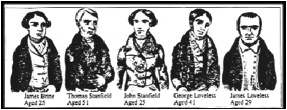Pete Goddard and Atul Hatwal continue their tour through Labour history with a look at the role of the unions in establishing the Labour representation committee (LRC) in 1900
For the unions, the road to the Labour representation committee started in a field in Dorset. Not an actual field, obviously. A road starting in a field wouldn’t be very useful, and nobody had yet invented EU infrastructure funding.
In 1832, six agricultural labourers from Tolpuddle gathered together and founded a friendly society. They aimed to protest against the lowering of wages in the area in the hope that they could afford the little luxuries in life, such as food.
The name friendly society was appropriate to the gentle pace of protest in the region. West country militancy had reached its peak a couple of years earlier, in nearby Wroughton in Wiltshire.
In response to cuts to welfare administered by the local church under the poor laws, working men marched along to the church’s graveyard and began smoking. Not in a Tibetan monk-protest type way. They simply lit their pipes and puffed away.
Outrageous.
The local gentry thought so anyway. As far as they were concerned pipes in the graveyard was the thin end of a wedge that inevitably led to mob rule and the guillotine. Sure, they called it a friendly society, but wasn’t that just marketing? In 1789 Parisians had probably been invited to the “unexpected open day of the Bastille” too.
James Frampton, Tolpuddle’s local landowner, was alert to the danger from the latest insurrection. He saw the threat from six labourers banding together to ask “would you mind oppressing us slightly less brutally please?” Surely he had to do something about this atrocity.
He considered the matter over a meal of roasted pauper and a fine claret, but it was a toughie, so he decided to enlist the support of a bigger, more important landowner.
Thus in 1834 he dashed off a missive to the prime minister, Lord Melbourne. The PM was equally enraged by this affront to natural injustice. Convinced of the need to put the peasants in their place, he exhumed an obscure law that prohibited people from swearing oaths to one another, which the Tolpuddle troublemakers had done.
The six men were tried, found guilty and sentenced to deportation to Australia. In this early pilot for I’m A Celebrity… – I’m a Martyr, there’s no getting out of here – they didn’t even have the benefit of Nadine Dorries’ company to soften the blow.
The Tolpuddle six were plonked on the transport ships bound for Australia. These ships were overcrowded vessels where disease was rife and travellers were lucky to get to their destination alive, a business model subsequently adopted by Ryanair. That said, the prison hulks eventually arrived in Australia, rather than dropping the prisoners in New Zealand and making them take a taxi the rest of the way.
Fortunately, back in Blighty, as well as rich land-owning prime ministers, there were also normal people. Quite a lot of them. There was a general outcry about the obvious injustice of the whole thing, supported by the unions who could clearly see how this was an attack on their very existence. Especially as most of them didn’t even have friendly in their name.
The unions got organised and campaigned for the Tolpuddle martyrs’ freedom. It caught the public’s imagination: over 100,000 people marched, over 800,000 people signed petitions and countless Facebook statuses were amended in protest. That’s the equivalent of half a million people marching and four million signatures today. As an outpouring of public feeling, it made the death of Diana look like a national gallic shrug.
The campaign was spectacularly effective (not the Facebook bit, obviously. That’s never effective). The pressure became too much and the government caved in completely. The six men were given a free pardon.
Winning the freedom of the Tolpuddle martyrs was the most significant demonstration to date of the power of the people – power that could be brought to bear in defence of workers’ rights.
Over the next 20 years accelerating industrialisation, and a casual disregard for the workers who were making it happen, meant more and more organisations of this nature started forming.
In 1851 in Aldgate, East London the amalgamated society of engineers was formed. This was followed the next year by the London trades council, then the carpenters and then the co-operative wholesale society in 1863.
Faced with this growing union movement it was clear to the owners and managers that they simply couldn’t deport the entire working class to Australia. And even if they could, who would do the hard work to keep their factories running? Not them, obviously.
What were they going to do?
Fortunately for them, the Tories had an answer. Benjamin Disraeli had a plan so cunning you could easily mistake it for a massive act of one nation social reform.
Coming next: “I’m alright Jack” say the skilled working classes
Pete and Atul are not historians
Tags: Atul Hatwal, Bastille, Lord Melbourne, Pete Goddard, Tolpuddle











Delightful…esp[especially the ‘open day’ at the Bastille and the ‘usual suspects’…can’t wait for the next part.
Oh…and uglyfatbloke IS a historian…..